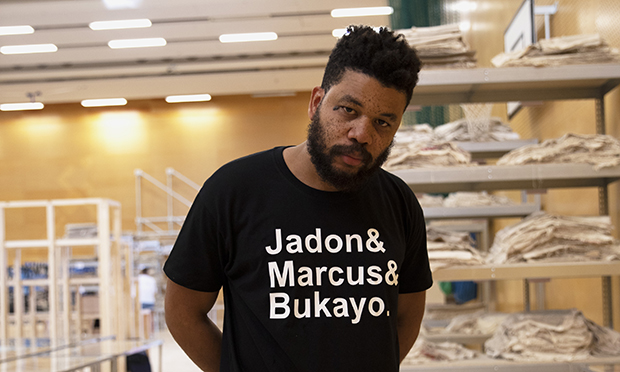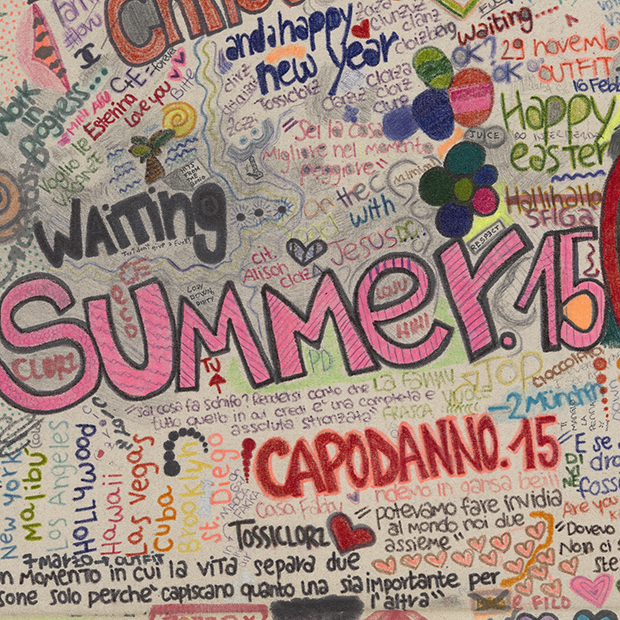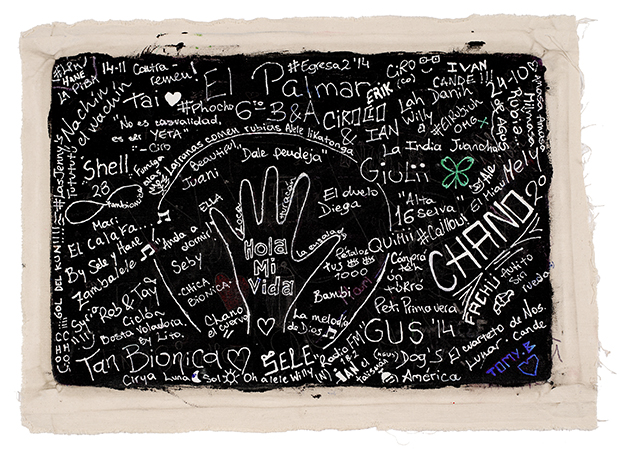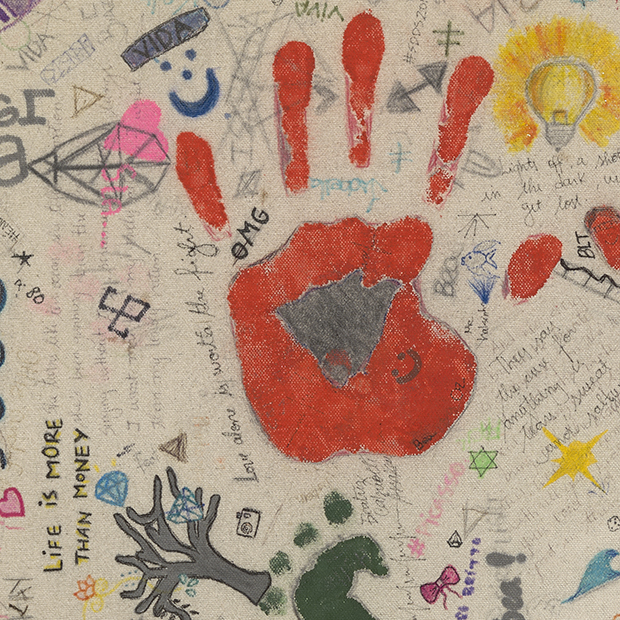Frequencies, Oscar Murillo, exhibition review: ‘Conceptual art at its finest’

Frequencies is an archive of 40,000 canvasses covered in doodles by children aged 10-16.
Over seven years, Turner Prize-winning artist Oscar Murillo arranged for children in 34 countries around the world to draw whatever they wanted on canvasses stuck to their desks. This exhibition showed every single one.
I walked past basketball hoops and high walls in the airy gym of Murillo’s alma mater, Cardinal Pole Catholic School.
I was sent back to my childhood, when inner thoughts and dreams were inked on notepads and desks and everything felt life-changing and immediate.
Band names, logos and worries about exams are scribbled on these canvasses.
An eerie city-scape shouts from a Malaysian child’s work; intricately drawn anime characters cover others; and one says ‘RIP 7/4/2015, you will forever be in my heart’.
The designs range from graffiti to beautiful flowers to careful, colourful, A-level-portfolio-worthy portraits.
Cautions against drug use decorate a canvas from Ghana, in a pale biro pen that tells a story of little resources. It’s interesting to see how the canvasses differ by country.

Curator Marina Doritis, one of the lead producers of Artangel, the charity that collaborated with Murillo on the project, said: “It’s trying to capture or trying to tell a story about children around the world. In some countries’ canvasses you can even see the environmental impact.
“The canvasses absorb all the fumes and perhaps the pollution of the city. Some of them are dark and some of them are pristine and clean. It tells you a wider story about the place that the school exists in.”
For one Cardinal Pole student who is working as an assistant at the exhibition, these insights brought him closer to his background.
Enrique said: “It really gives you an idea of what it’s like to be in these places. I’m Ghanaian and I’ve never been to Ghana, but looking at the canvasses, it almost feels like I get a snapshot of what it would be like to be there.”
Noticing western motifs on some of those canvasses, he added: “It shows that the world isn’t as disconnected as you would assume. There’s a lot more unity that you would expect.
“It’s hard not to be inspired, especially by the quality of some drawings.”

According to Murillo, the canvasses portray the “conscious and unconscious energy of young minds at their most absorbent and fluid”.
Murillo was also thinking about the “purity” of drawing.
He said: “I felt that, historically, artists like Picasso or Dubuffet discussed the idea of drawing in terms of purity. In my case I wanted to explore those ideas directly with the source, the child.”
Murillo’s inspiration for the project came from seeing doodles on desks when visiting his old school. His move to the UK from Columbia aged 10, and the trauma of being dropped into a different culture is also at the core of Frequencies.
The project started small, as Murillo sent canvasses to one school in Columbia, and he then worked with political scientist Clara Dublanc to send canvasses to more and more schools across the globe, from India to Mexico, Slovenia to China and all around. The duo have now formed the Frequencies Foundation to fund education and art projects.
Artangel carefully chose guest selectors each week for the rotating display of around 40 canvasses on tables, including the winner of the global teacher award, Andria Zafirakou, the coder Jazmin Morris, the singer Nkisi, psychoanalyst Adam Phillips and a group of students at the school.

While fragments of the collection has been shown at past exhibitions, this is the first time the collection has been presented in such a comprehensive way, and it has a high impact.
Doritis said: “There’s a universal experience and universal way of putting thoughts down on the table. It resonates with everyone.”
The canvasses could be retrieved and shown to visitors by the school’s students, who were working as paid gallery assistants. They used gloves to handle the precious archived drawings that might otherwise have been seen as bits of teenage mischief in a different setting.
The canvasses will all be digitalised, like the one per cent of them shown on a screen in the hall. The exhibition also showcases art by Murillo himself: children’s canvasses stitched together with his own sea of rough blue paintings, which are very arresting.
Alex Parker, a teacher at Cardinal Pole, said: “We’re really grateful to Oscar for having requested that our students should be given the opportunity to do this off the back of his success.
“Injecting such a heavy dose of the art world into the school is an opportunity for the students to meet people they might not ordinarily come into contact with. The students have taken everything on with incredible professionalism and confidence.”
The exhibition is conceptual art at its best. Exploring this wide representation of children’s inner consciousness in different environments was absorbing.
Frequencies ran until 30 August Cardinal Pole Catholic School, 205 Morning Lane, E9 6LG.
